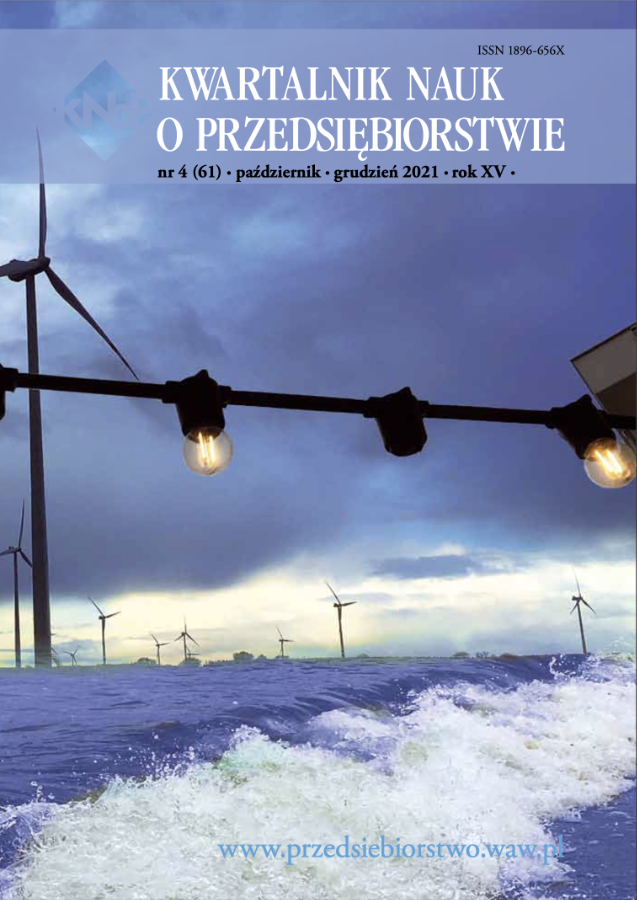Physical proximity and innovation collaboration of the Polish small and medium knowledge-intensive enterprisese
Abstract
Globalisation, with its rising global value chains and the complexity of innovationprocesses change the role of spatial distance in innovation activities. In the classicalcluster theories geographical proximity is seen as a necessary condition to share knowledgeand to enhance innovation collaboration. The recent literature, however, challenge this approachby claiming that the role played by spatial distance diminishes. The aim of this paperis to provide better understanding of the role physical and geographical proximities inthe innovation collaboration process. The paper presents the up-to date results on the roleof physical proximity in innovation collaboration process of the Polish knowledge intensiveSMEs. The study findings support the idea that physical proximity matters for the innovationinteractions, yet the geographical proximity is not a prerequisite for such collaboration.Moreover, the innovative interlinkages of the surveyed companies have more individualcharacter, and are equally determined by the companies technological profiles andsocial-individual connections.
Full text article
References
2. Autant-Bernard C., Billand P., Frachisse D., Massard N. (2007), Social distance versus spatial distance in R&D cooperation: Empirical evidence from European collaboration choices in micro and nanotechnologies, “Papers in Regional Science”, 86, pp. 495-519.
3. Breschi S., Lissoni F. (2001), Knowledge Spillovers and Local Innovation Systems: A Critical Survey, “Industrial and Corporate Change”, 10(4), pp. 975-1005, DOI: 10.1093/icc/10.4.975
4. Breschi S., Lissoni F. (2009), Mobility of skilled workers and co-invention networks: an anatomy of localized knowledge flows, “Journal of Economic Geography”, Vol. 9, Issue 4, July 2009, pp. 439-468, DOI: org/10.1093/jeg/lbp008.
5. Cairncross F. (1997), The Death of Distance: How the Communications Revolution Will Change Our Lives, Harvard Business Review Press.
6. Castells M. (1996), The Rise of the Network Society. The Information Age, “Economy, Society and Culture”, Vol. I.. Oxford: Blackwell.
7. Doloreux D., Parto S. (2005), Regional Innovation Systems: Current Discourse and Unresolved Issues, “Technology in Society”, 27(2), pp. 133-53.
8. Frenken K., Hardema S., Hoekman J. (2009), Spatial scientometrics: towards a cumulative research program, “Journal of Informetrics”, 3(3), pp. 222-232, DOI: 0.1016/j.joi.2009.03.005.
9. Glaeser E.G. (2000), The Future of Urban Research: Non-Market Interactions, Brookings-Wharton Papers on Urban Affair.
10. Grossetti M. (2005), Where do social relations come from?: A study of personal networks in the Toulouse area of France, “Social Networks”, 27, pp. 289-300.
11. GUS (2021), Innovation activities of enterprises in the years 2017-2019, GUS, 2021, https://stat.gov.pl/en/topics/science-and-technology/science-and-technology/innovation-activities-ofenterprises- in-the-years-2017-2019.
12. Harabi N. (1997), Channels of R&D spillovers: An empirical investigation of Swiss firms, “Technovation”, 17, pp. 627-635, DOI:10.1016/S0166-4972(97)00064-3.
13. Heinisch D., et al. (2016), Same place, same knowledge-same people? The geography of non-patent citations in Dutch polymer patents, “Economics of Innovation and New Technology”, 25(6), pp. 553-572, DOI: org/10.1080/10438599.2015.1081333.
14. Maurseth P.B., Verspagen B. (2002), Knowledge spillovers in Europe: a patent citations analysis, “Scandinavian Journal of Economics”, 104 (4), pp. 531-545.
15. Moulaert F., Sekia F. (2003), Territorial Innovation Models: A Critical Survey, “Regional Studies”, 37(3), pp. 289-302, DOI:10.1080/0034340032000065442.
16. 16. Nooteboom B. (2001), Learning and innovation in organizations and economies, Oxford: Oxford University Press, DOI:10.1093/acprof:oso/9780199241002.001.0001.
17. Piergiovanni R., Santarelli E. (2001), Patents and the Geographic Localization of R&D Spillovers in French Manufacturing, “Regional Studies”, 35(8), pp. 697-702, DOI:10.1080/00343400120101434.
18. Ponds R., Frenken K.,von Oort F. (2007), The Geographical and Institutional Proximity of Research Collaboration, “Papers in Regional Science”, 86(3), pp. 423-443, DOI:10.1111/j.1435-5957.2007.00126.
19. Porter M. (2003), Clusters and regional competitiveness: recent learnings, Paper presented at the international conference on technology clusters, Montreal, 7 November 2003, www.isc.hbs. edu/pdf/ Montreal_Cluster_Conference_2003.11.07_ckrb.pdf.
20. Romanowska M. (2017), Autystyczne postawy polskich przedsiębiorstw w zakresie innowacji. Presentation at the seminar: Otwarte innowacje wyzwaniem współczesnego zarządzania, 20.03.2017, SGH w Warszawie.
21. Runiewicz-Wardyn M. (2020), Social Capital In the University-Based Innovation Ecosystems In the Leading Life Sciences Clusters. Implications for Poland., Poltext, Warszawa.
22. Runiewicz-Wardyn M. (2013), Knowledge Flows, Technological Change and Regional Growth in the European Union, Springer, London.
23. Singh J. (2005), Collaborative networks as determinants of knowledge diffusion patterns, “Management Science”, 51 (5), pp. 756-770.
Authors
The author of the article declares that the submitted article does not infringe the copyrights of third parties. The author agrees to subject the article to the review procedure and to make editorial changes. The author transfers, free of charge, to SGH Publishing House the author's economic rights to the work in the fields of exploitation listed in the Article 50 of the Act of 4 February 1994 on Copyright and Related Rights – provided that the work has been accepted for publication and published.
SGH Publishing House holds economic copyrights to all content of the journal. Placing the text of the article in a repository, on the author's home page or on any other page is allowed as long as it does not involve obtaining economic benefits, and the text will be provided with source information (including the title, year, number and internet address of the journal).

